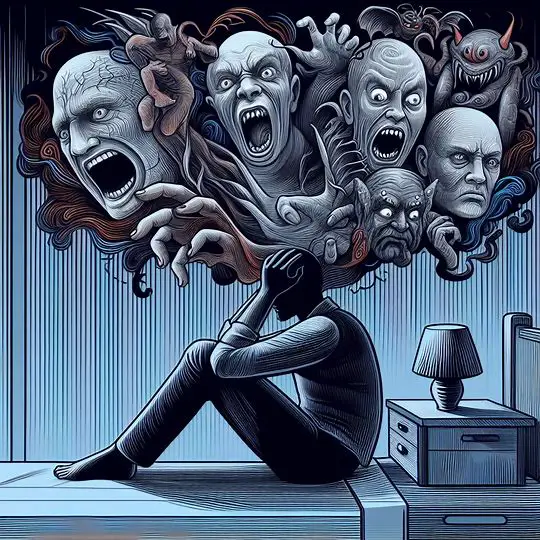Explore our expert guide on Disturbing Thoughts and learn how to navigate mental health challenges confidently and clearly. Find strategies to understand and cope effectively.
Table of Contents
Introduction – Disturbing Thoughts
Disturbing thoughts sometimes referred to as intrusive thoughts, are unwelcome ideas or images that can suddenly pop into your mind, often causing considerable anxiety and discomfort. These thoughts can be alarming and may involve themes of violence, sexual misconduct, or catastrophic events despite being inconsistent with the individual’s values or intentions. While everyone might experience an unsettling thought at some point, the persistent and repetitive nature of these thoughts can seriously hinder a person’s daily life. It can be indicative of an underlying mental health disorder.

Understanding and addressing disturbing thoughts is an essential step towards mental wellness. For most people, these thoughts are fleeting and benign, but for others, they can become more persistent, leading to distress and sometimes even impacting behaviors. The effects of these thoughts are shaped by various factors, including the context in which they arise and the individual’s ability to manage them. The development of distressing thoughts can be influenced by stress, traumatic events, or mental health conditions such as anxiety disorders or obsessive-compulsive disorder (OCD).
Key Takeaways
- Disturbing thoughts are unwanted and can cause significant anxiety, though they are a common experience.
- Persistent disturbing thoughts may impact mental health and daily functioning, indicating a potential mental health condition.
- Identifying and implementing treatment strategies is crucial for managing and reducing the impact of disturbing thoughts.
Understanding Disturbing Thoughts

In this section, we explore the phenomenon of unwanted and intrusive thoughts disrupting daily life, offering insights into their nature, typical manifestations, and recognition of their commonality.
Defining Intrusive and Disturbing Thoughts
Intrusive and disturbing thoughts refer to unwelcome, often distressing thoughts, images, or impulses that enter the mind unbidden. They are a common occurrence within the spectrum of mental health and can take various forms, from violent thoughts to irrational worries. These thoughts can be particularly troubling if they involve harm to oneself or others or revolve around socially taboo topics such as sexual acts.
Common Types and Manifestations
These unwanted thoughts can encompass an array of subjects, with some individuals experiencing violent thoughts, while others may have thoughts related to sexual acts, doubts, or severe worries. The thoughts can be vivid images, or abstract, involving complex fears about one’s future or competence.
Prevalence and Normalization
Research suggests that having occasional intrusive thoughts is a universal human experience. Their prevalence indicates that such thoughts are a normal aspect of mental health. However, when the frequency or intensity of these thoughts causes significant distress, it may indicate an underlying health issue that requires professional attention.
| Key Findings | Source URL |
|---|---|
| Intrusive thoughts are a common mental health issue | Harvard Health |
| They can include violent imagery or fears of illness or harm | Verywell Mind |
| Most people experience them, but they’re problematic if they cause distress. | Healthline |
| Relevant Keywords & Entities |
|---|
| Intrusive thoughts |
| Occasional intrusive thoughts |
| Mental health |
| Violent thoughts |
| Sexual acts |
| Images |
| Doubts |
| Worries |
Causes and Triggers

Understanding the causes and triggers of disturbing thoughts requires an exploration of various factors, be it psychological, biological, environmental, or based on past experiences. These factors can interplay and manifest as intrusive thoughts.
Psychological and Biological Factors
The human brain can generate disturbing thoughts due to various psychological and biological factors. Conditions such as obsessive-compulsive disorder (OCD) and anxiety are often associated with the occurrence of intrusive thoughts. A person with OCD, for example, might experience persistent, unwanted thoughts that cause significant distress.
Stress and Environmental Influences
Stress is a common trigger for intrusive thoughts. High levels of stress can overwhelm the brain’s capacity to handle information, resulting in the emergence of disturbing thoughts. Environmental influences such as exposure to certain songs or news stories can also act as triggers, reminding an individual of past concerns or fears.
Past Traumatic Events
Traumatic events from the past can heavily influence the presence of disturbing thoughts. Individuals with post-traumatic stress disorder (PTSD) may relive trauma through vivid, intrusive thoughts. The connection between past trauma and these thoughts is a key area of focus when addressing the treatment and management of PTSD.
| Key Concepts | Related Information |
|---|---|
| OCD | Associated with persistent, unwanted thoughts that can cause distress. |
| PTSD | Triggers intrusive thoughts that are often flashbacks to a traumatic event. |
| Stress | Can prompt the emergence of disturbing thoughts. |
| Anxiety | Future-facing emotions that may exacerbate the frequency of intrusive thoughts. |
Relevant Sources:
- “Coping with unwanted and intrusive thoughts – Mayo Clinic Press,” Mayo Clinic
Mayo Clinic Press - “What Are Intrusive Thoughts? And How To Stop Them,” Cleveland Clinic
Cleveland Clinic - “Intrusive Thoughts: What They Are and How to Let Go,” Verywell Mind
Verywell Mind
| Causes of Disturbing Thoughts | Source URL |
|---|---|
| Psychological disorders such as OCD | Mayo Clinic Press |
| Stress and Anxiety | Healthline |
| Environmental triggers | Cleveland Clinic |
| Past Traumatic Events and PTSD | Verywell Mind |
Impact on Mental Health

Disturbing thoughts can affect an individual’s mental health, causing a range of emotional and behavioral complications and impacting personal relationships. These thoughts are often linked with various mental health conditions, inducing feelings of distress and influencing one’s daily life.
Correlation with Anxiety Disorders
Individuals with anxiety disorders may experience disturbing thoughts that amplify their worries and fears. In cases of Obsessive-Compulsive Disorder (OCD), these thoughts can become obsessions, leading to significant anxiety and repetitive behaviors or compulsions aimed at reducing this anxiety. Similarly, people with Post-Traumatic Stress Disorder (PTSD) often have intrusive thoughts related to their trauma, further perpetuating their condition.
Effects on Mood and Behavior
Persistent disturbing thoughts can lead to mood fluctuations, often causing or exacerbating symptoms of depression. The continual battle with these thoughts can result in feelings of shame and distress, potentially leading to withdrawn behavior, irritability, or a noticeable decline in personal care and daily functioning.
Influence on Relationships and Communication
The impact of disturbing thoughts on relationships and communication can be profound. Individuals may struggle to convey their experiences or may withdraw from social interactions to avoid the discomfort of sharing intrusive thoughts with others. This can strain relationships, sometimes creating misunderstandings and isolation.
| Key Findings | Related Keywords |
|---|---|
| Individuals with anxiety disorders like OCD may have repetitive and unwanted disturbing thoughts. | Obsessive-Compulsive Disorder (OCD), anxiety |
| Intrusive thoughts are common in people with PTSD and can trigger anxiety and distress. | Post-Traumatic Stress Disorder (PTSD), distress |
| Disturbing thoughts may influence mood and behavior, potentially leading to depressive symptoms and behavioral shifts. | depression, mood fluctuations |
| Communication and relationships can be adversely affected due to the reticence to share intrusive thoughts. | relationships, communication |
For detailed insights on coping with disturbing thoughts, the Mayo Clinic addresses these concerns within the context of mental health conditions like OCD and PTSD. The discussion on intrusive thoughts and their relationship to anxiety disorders can be further explored in articles from reputable health sources, such as Coping with Unwanted and Intrusive Thoughts and Managing Intrusive Thoughts. The impact on mood, behavior, and relationships is addressed in resources like Intrusive Thoughts: What They Are And How To Cope and Intrusive Thoughts Are All in Your Head.
Treatment and Management Strategies

Effective management of disturbing thoughts often involves a combination of therapy, medication, and self-help strategies. Healthcare professionals can guide individuals towards appropriate treatments based on the type and severity of their symptoms.
Cognitive Behavioral Therapy (CBT)
Cognitive Behavioral Therapy (CBT) is a commonly recommended treatment for managing intrusive thoughts. It involves working with a therapist to identify and change negative thought patterns and behaviors. A key goal of CBT is to teach individuals coping strategies to deal with their thoughts more healthily.
Exposure and Response Prevention (ERP)
Following closely with CBT principles, Exposure and Response Prevention (ERP) is a type of therapy specifically effective for obsessive-compulsive disorders. It entails gradual exposure to the source of anxiety and teaching patients to refrain from the compulsive behaviors that typically follow.
Medications and Professional Care
For some individuals, medications such as Selective Serotonin Reuptake Inhibitors (SSRIs) are necessary alongside therapy. A healthcare professional prescribes these medications and can help to reduce the occurrence of intrusive thoughts over time.
Self-Help Techniques and Lifestyle Changes
Lifestyle adjustments and self-care techniques can also be instrumental in managing disturbing thoughts. Mindfulness and meditation are self-help practices that focus on living in the present and may lessen the power of intrusive thoughts. Regular exercise and a balanced diet also contribute to overall mental health.
| Key Concepts | Description | URL |
|---|---|---|
| Cognitive Behavioral Therapy (CBT) | A form of therapy focusing on changing negative thought patterns and behaviors | Harvard Health |
| Exposure and Response Prevention (ERP) | A therapy technique where patients are exposed to fears to prevent a compulsive response | Mayo Clinic Press |
| Medication | Often SSRIs are used to help reduce symptoms of anxiety and intrusive thoughts | Cleveland Clinic |
| Mindfulness | Focusing attention on the present moment to reduce anxiety and intrusive thoughts | Verywell Mind |
Key findings suggest therapeutic strategies like CBT and ERP, possibly combined with medication, are effective in treating and managing disturbing thoughts. Additional strategies like mindfulness, meditation, and lifestyle changes complement these methods and can empower individuals to enhance their mental well-being.
Prevention and Support

Effective management of disturbing thoughts includes building a strong support system and implementing prevention and awareness strategies. These methods not only provide reassurance but also promote self-care, helping to mitigate issues like lack of sleep which can exacerbate intrusive thoughts.
Building a Support System
A foundation of close loved ones and a mental health provider establishes an important safety net. Individuals benefit from the company of friends and family who offer comfort and understanding. Regular consultations with a mental health professional allow for tailored support that may include therapy or medication.
| Entity | Relation to Support System |
|---|---|
| Loved Ones | Offer emotional comfort and practical assistance |
| Mental Health Provider | Provides professional guidance and treatment options |
Prevention and Awareness Strategies
Educating oneself on disturbing thoughts through mindfulness meditation and other resources can build awareness and foster sensitivity to early signs of distress. Mindfulness techniques help maintain focus on the present moment, reducing anxiety. Adequate self-care routines, including sleep and relaxation, are crucial for mental health maintenance.
Self-care, like ensuring one isn’t floating in a chaotic schedule or suffering from a lack of sleep, is vital. Such proactive measures help maintain equilibrium and reduce vulnerability to intrusive thoughts.
| Strategy | Benefits |
|---|---|
| Mindfulness Meditation | Enhances attention control, reduces anxiety |
| Education | Increases awareness, informs about coping mechanisms |
| Self-Care | Promotes overall well-being, improves sleep quality |
By embracing these strategies, individuals can better manage and prevent disturbing thoughts.
Frequently Asked Questions
This section addresses some of the most common queries people have about intrusive thoughts, their significance, and how they can be managed.
What are some common examples of intrusive thoughts?
Intrusive thoughts can take many forms, ranging from fears about safety to unwanted, aggressive or sexual thoughts. Typically, these are thoughts that one finds distressing and out of character, such as worry about harming loved ones or fears of contracting illnesses. Mindfulness practices can help individuals observe these thoughts without judgment, alleviating their impact.
Can intrusive thoughts be indicative of an underlying mental health condition?
Yes, intrusive thoughts are sometimes associated with mental health conditions like anxiety, depression, or obsessive-compulsive disorder (OCD). They can manifest as persistent worries or unwanted ideas that can be distressing for the individual experiencing them. It’s important to consult a healthcare professional if such thoughts are causing significant distress or impairment.
Are people with violent intrusive thoughts likely to act on them?
Generally, people with violent intrusive thoughts are not likely to act on them. These thoughts are usually a reflection of anxiety, not an individual’s true desires. In fact, the presence of distress about these thoughts typically indicates that the individual does not wish to act on them and finds them abhorrent.
What strategies can help in managing intrusive thoughts effectively?
Techniques such as exposure and response prevention, cognitive-behavioral therapy, and mindfulness meditation have been shown to help manage intrusive thoughts. Grounding techniques, like focusing on the present environment, can also be beneficial. Individuals are encouraged to seek guidance from a mental health professional for personalized strategies.
What is the typical duration for intrusive thoughts to persist?
The duration of intrusive thoughts can vary widely depending on the individual and their circumstances. Some may experience them briefly while for others they can persist for a longer time. Without intervention, intrusive thoughts may reoccur, hence seeking help is crucial in managing their persistence.
What role do medications play in the treatment of intrusive thoughts?
Medications, particularly antidepressants and anxiety-reducing drugs, can play a role in alleviating the frequency and intensity of intrusive thoughts for some individuals. Medications are often more effective when combined with therapy. A healthcare provider can deliver an appropriate treatment plan based on a person’s specific needs.
| Keyword | Source URL |
|---|---|
| Intrusive thoughts examples | Verywell Mind |
| Mental health conditions | Mayo Clinic Press |
| Anxiety and violent thoughts | Harvard Health |
| Strategies for managing | Cleveland Clinic |
| Medications for intrusive thoughts | ADAA |
| Key Findings | Related Keywords |
|---|---|
| Mindfulness exercises can reduce anxiety and intrusive thoughts. | Mindfulness, anxiety |
| Intrusive thoughts are often not acting upon. | Violent thoughts, anxiety |
| Duration of intrusive thoughts varies. Seeking help can manage persistence. | Duration, therapy |
| Medications are effective, especially when combined with therapy. | Antidepressants, anxiety-reducing drugs |



